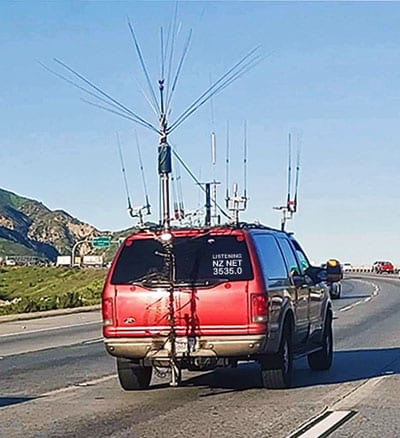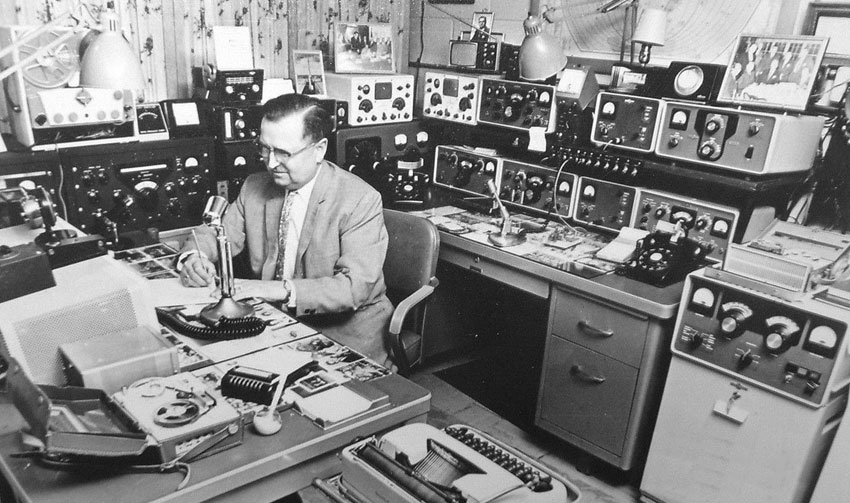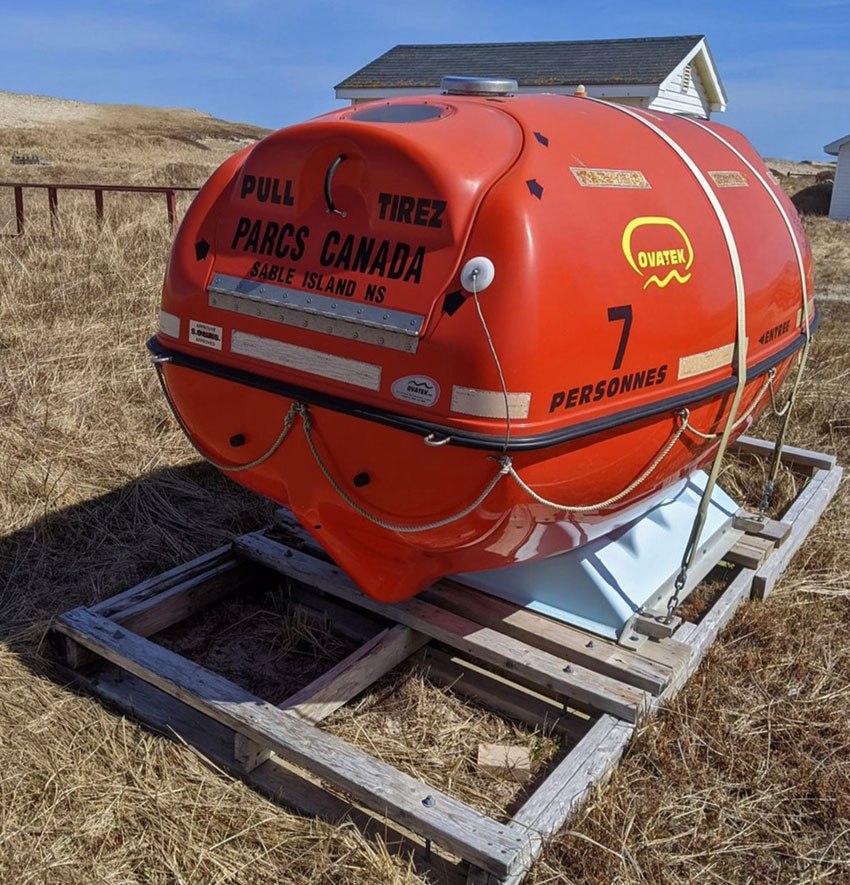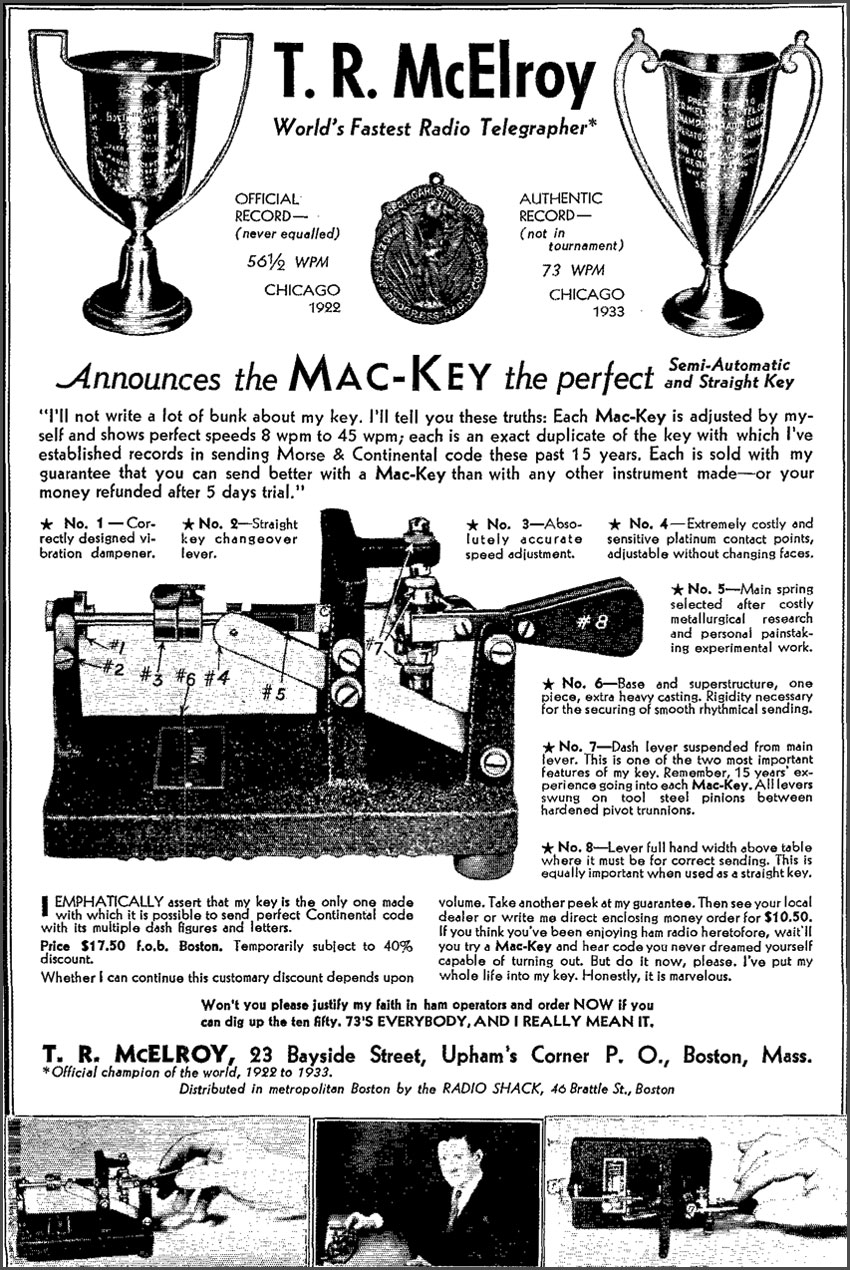This is a free fortnightly newsletter about the New Zealand Net.
If you would like to be notified by email when a new edition is published, please contact ZL1NZ.
Browse our Newsletter Archive and List of Net Tips.
Featured key

Photo: ZL4KX
By Bede ZL4KX
This is the famous and rare Zedder key, made by Peter Byam ZL2JJ for me in 1994. I saw a review of the key, and sent an enquiry. Peter replied with a very comprehensive letter with all the details. It is serial 005 and has my callsign attached.
It was (at the time) a huge amount of money for a lowly paid electronics tech with a big mortgage, but working on the principle I would never need to buy another, I sent off my $403, including postage.
In return I received a 2.2 kg marvel of engineering. It is by far the heaviest key I own, and it is an extremely nice one to use. A few months later Peter sent me new stainless steel springs at no cost, as he was not 100% happy with the plated steel originals.
I had been using my first proper paddle, a Bencher BY1, for 11 years and the Zedder was a bit different. By modern standards it has a weighty action, as it has long pivots points. But since it could be set to almost microscopic contact gap this didn’t really matter. And the settings didn’t move. It has four sealed ball bearings supporting the arms and has no vertical play at all.
Over the past nearly 30 years the brass components have darkened somewhat but In the interests of leaving things well enough alone, it will be left that way. The base is cast bronze, described by Peter as Herculoy, and has a cavity for the connections. It sits on three cork feet, which are still in great condition. Listen out for it in use when its turn appears on the rotation of all the other paddles I have bought in the years since!
* If you have an interesting key for this feature, please send me a nice clear photo and a few words describing it.
Quick notes

Thanks to the ops who participated in Marconi Week on NZ Net, sending messages about the “father of radio” during the week of 17 April. And I hope you all had a happy Morse Code Day on Thursday.
What computer logging? I was surprised by the four Field Day photos on the cover of the latest Break-In magazine. For quite a while now we’ve been told that computer logging, and even sending CW by computer, is the proper way to operate in a contest. But I don’t see any computers on the cover of Break-In – just tidy pads of paper. I sympathise with contest managers who would like to reduce the work of processing logs, but maybe computer logging doesn’t appeal to everyone.
Steve ZL2KE received a home-made birthday card this week from his 11-year-old granddaughter, Aria, and it included a “secret message” in Morse Code, perfectly set out in dots and dashes. Steve says he’s never discussed Morse Code with his granddaughter but I’d say she’s got what it takes to be a Morse operator, wouldn’t you? See Aria’s message in our Morse Challenge later in this newsletter.
Gerard ZL2GVA was the winner of the QRP CW section of the recent ZL Winter Sprints.
Paul ZL1AJY (who, incidentally, appears on the cover of the latest Break-In) has been scanning the bands and writing up his amateur radio discoveries. Among them: “The length of transmissions is inversely proportional to signal strength and readability.”
Photo flashback

Felton Jenkins K0ZZR Minneapolis in the 1960s
Felton must have been a traffic handler; he had two telephones, each with a hands-free shoulder rest. Remember those? My neck gets sore when I think about them. 🙂
Hams exchange trans-Tasman greetings
The first amateur radio contact between New Zealand and Australia occurred on 26 April 1923. Frank Bell in Otago and Charles Maclurcan in Sydney make contact on 160 metres. On the centenary of this event, two messages were exchanged across ‘the ditch’ to mark the occasion.
During the weekly VKCW Net on 20 metres, I sent the following:
NR28 R ZL1NZ 23/20 AUCKLAND 0600Z 26APR23 = VKCW NET = GREETINGS TO COLLEAGUES IN AUSTRALIA ON THIS 100TH ANNIVERSARY OF FIRST TRANS TASMAN AMATEUR RADIO CONTACT BY BELL AND MACLURCAN = ZL1NZ
During the same net, and later on the NZ Net, we had this message from Manny VK3DRQ:
NR20 R VK3DRQ 23/19 BLACKBURN 1230Z 24APR23 = ZL AND VKS = CONGRATULATIONS TO ALL ZL AND VK AMATEUR RADIO ON THE CENTENARY OF THE FIRST TRANS TASMAN AMATEUR RADIO CONTACT = VK3DRQ
Nothing beats a good aerial
 About six months after making the first trans-Tasman amateur radio contact, Frank Bell and Charles Maclurcan were in contact again, during October 1923, proving that even very low power signals could cross the Tasman on wevelengths of 150-170 metres. Maclurcan’s transmitter power was just 3.7 milliwatts, but Bell copied him.
About six months after making the first trans-Tasman amateur radio contact, Frank Bell and Charles Maclurcan were in contact again, during October 1923, proving that even very low power signals could cross the Tasman on wevelengths of 150-170 metres. Maclurcan’s transmitter power was just 3.7 milliwatts, but Bell copied him.
And a year after that Bell (pictured here in 1916) communicated with Cecil Goyder at G2SZ in London, setting a virtually unbeatable distance record of some 12,000 miles.
Bell didn’t consider his equipment to be anything special – but he was very pleased with the performance of his aerial. He said:
“I use a straight-out Hartley circuit, and one UV 203 or 50-watt radiotron. The input never exceeds 130 watts. I attribute most of my success to my 97-foot lattice tower. Ever since I put this up, the DX has poured in. I have been heard in a good many of the islands of the Pacific, such as Tahiti and Hawaii, and all over Australia, in the Argentine, the USA and Canada. The receiver used for all traffic work is just a simple detector and one audio of the ‘Low Loss’ type. I also have a broadcast receiver using 3 RF (radio frequency) detector, 1 AF (audio frequency) detector, 1 AF (audio frequency), and 2 Power (amplifying valves), which brings in music well.”
Morse challenge
 Here is part of Aria’s lovely birthday card to her grandfather Steve ZL2KE.
Here is part of Aria’s lovely birthday card to her grandfather Steve ZL2KE.
You’ll notice that Aria even includes a special character at the end. So special, in fact, that it’s not even in the official ITU list of Morse characters – although it is known to many experienced Morse operators.
Your challenge is to decode the special character.
Please send your answer to ZL1NZ via radiogram, or via email if no propagation.
Answer to previous Morse challenge
 The Morse question in NZ Net News 104 asked readers to identify an unusual object and explain its purpose on Sable Island.
The Morse question in NZ Net News 104 asked readers to identify an unusual object and explain its purpose on Sable Island.
The object is a hard-shell life raft and there are actually two of them on the island.
They are to be used by staff of the weather station in case the island is about to be overwhelmed by a tsunami.
Imagine what a ride that would be – and who knows where the raft would end up!
Correct answers were received from ZL2GVA.
Not quite the end of the telegram
The era of commercial telegrams in the USA came to a quiet end in 2006, when Western Union announced it had delivered its final telegram.
On that occasion, National Public Radio (NPR) marked the passing of the telegram into “the dustbin of history.”
Although commercial telegrams may have disappeared in the USA, you can still send a telegram in Canada.
And of course, radiograms are alive and well on NZ Net and on countless other amateur radio CW nets around the world!

Video: AM broadcast DXing in Finland
How many of us got interested in radio by tuning around on the kitchen radio to see what DX we could pick up?
That’s certainly how I spent many evenings as a child, and AM radio (medium wave broadcast) DXing still attracts some dedicated followers:
Advertising archive
I just love the text in this advertisement and I urge you to read every word. Ted McElroy was a salesman for sure, but he was also passionate about Morse Code and mighty good at it. Possibly the best operator ever.
Ted was adamant about point number 8 in this advertisement, and for more on that, please see the article in NZ Net News 45.

QST magazine advertisement for the first McElroy bug, December, 1934
Suggestions?
If you have suggestions on how to make the NZ Net better, or things you’d like to see covered in these updates, please contact ZL1NZ. You might even like to write something for the newsletter.
Thanks for reading, and I hope to hear you soon on the NZ Net!
—
Neil Sanderson ZL1NZ, Net Manager
New Zealand Net (NZ NET)
3535.0 kHz at 9pm NZT Mon-Fri



